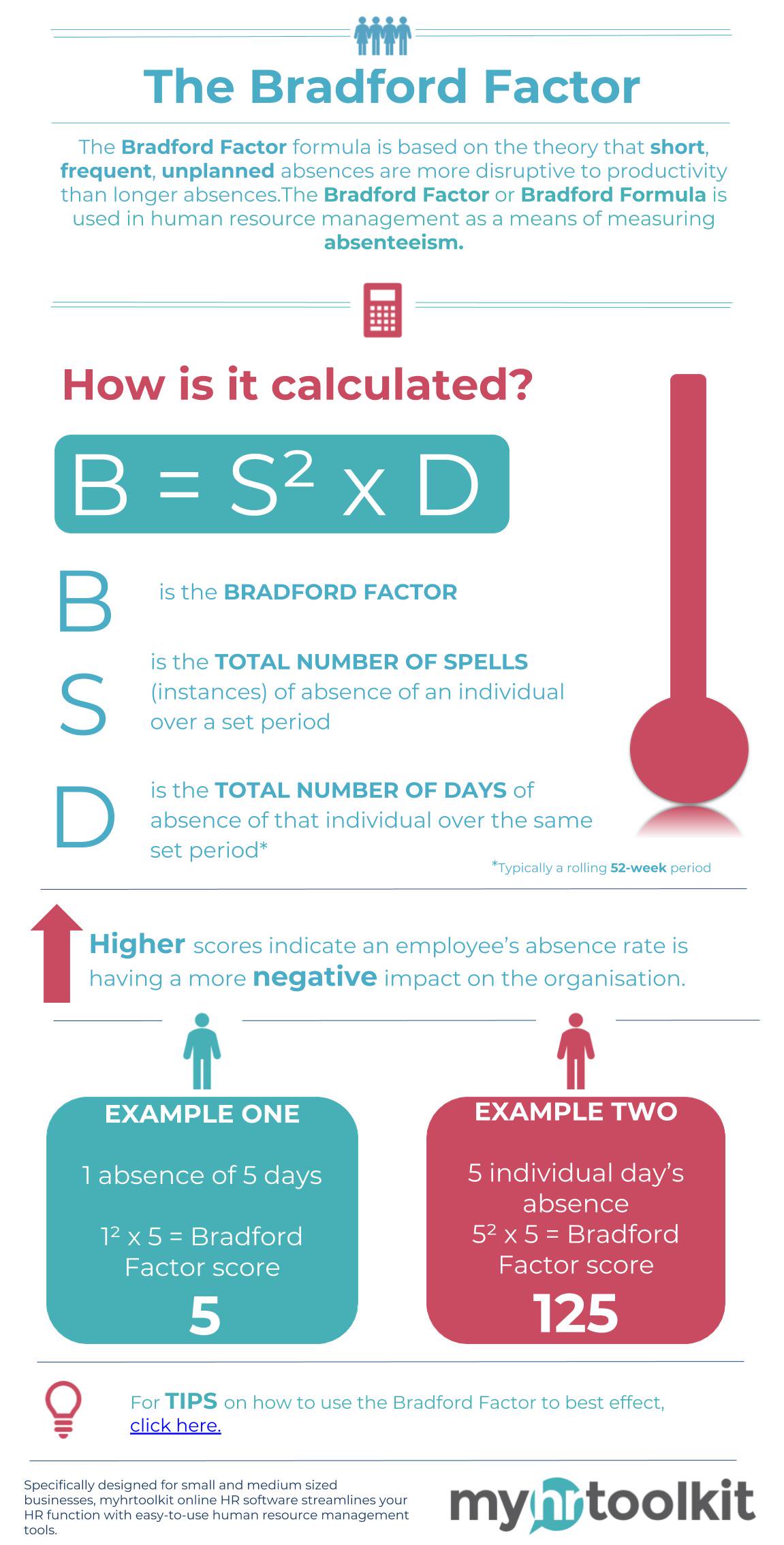The Bradford Factor, also referred to as the Bradford Formula or Index, is a useful absence management tool. It enables managers to assess the absence record of their employees via the calculation of a Bradford score.
The Bradford Factor introduces score ratings to help you identify areas of concern relating to staff sickness absence. The formula gives more weighting to regular short-term sick leave than to infrequent, longer term absence. This is because the Bradford Index supports the belief that short, frequent absences are more disruptive to businesses than longer absences.
Infographic: What is the Bradford Factor?
To summarise The Bradford Factor, view our handy infographic below:

How is the Bradford formula calculated?
Typically based on a rolling 52 week period, the Bradford Factor uses the formula S2 x D = B.
- S is the total number of instances of absence an employee incurs
- D is the total number of days’ absence they have taken
- B is the resulting Bradford Factor score
Bradford Factor example
An employee that has taken 1 sick day on four occasions will have a Bradford factor score of 64. On the other hand, an employee who has been off sick once for 4 days will have a score of 4.
While the impact of the above two absences will vary from business to business, the Bradford factor offers you a simple tool to monitor and manage sickness absence.
When does a score become of concern?
Different organisations may use the Bradford Factor in a variety of ways. Many will set lower thresholds to trigger a manager/employee conversation. This will help you identify issues as early as possible.
However, this score can vary depending on your industry, department and role. In some industries, work-related illness can be a typical cause of absence. For example, back problems in the construction industry or stress levels in nursing. Therefore, it's important that you communicate with your staff to ensure you understand the reason for their absences.
How to use the Bradford Factor to best effect
- By setting trigger points for scores, you can take the relevant action at the right time. If a score becomes concerning, you can use it to start a conversation about an employee’s sick leave.
- In some instances, you may be able to support an employee and help them address the problem. In other cases, the fact that you have raised concerns can deter a dishonest employee from absenteeism.
- Similarly, you can also set threshold scores for taking more serious action to tackle problem absences. By setting trigger points for disciplinary action or dismissal, you're armed with valuable data to support those decisions.
- Aside from monitoring individual employee absence, the Bradford Factor can also help you benchmark different departments within a business. You may expect different rates of absence between an executive board and a call centre. However, wildly varying scores across similar departments might indicate issues that need addressing within particular teams.
By flagging up such issues, you can then take proactive steps to increase employee engagement and wellbeing in those departments. Alternatively, you can task the heads of department with working to reduce departmental scores themselves.
Using the Bradford Factor in your business
As with any business management tool, how you introduce and deliver it is always key to its success. Whilst the Bradford Factor is aimed at improving performance, its misuse can easily have the opposite effect on your business.
If you're going to use the Bradford Factor, it's important to ensure your staff understand how it is calculated. Also, it will be applied in a fair and reasonable manner, for example through the use of Bradford Factor software.
Setting low thresholds and failing to properly discuss issues with your staff can actually lead to stress, demotivation, and absence. When used fairly, the Bradford Factor can be one of your most powerful absence management tools.
Using HR software to calculate Bradford scores
To see how you can create quick and easy Bradford Factor reports, book a free demonstration of myhrtoolkit’s absence management software by getting in touch.
Find out how absence management software can help you calculate Bradford Factor scores and track sickness absence in your organisation with full oversight.

Written by Fiona Sanderson
Fiona is Marketing Manager at myhrtoolkit. Her areas of expertise include HR systems, productivity, employment law updates, and creating HR infographics.


 Holiday Planner
Holiday Planner Absence Management
Absence Management Performance Management
Performance Management Staff Management
Staff Management Document Management
Document Management Reporting
Reporting Health and Safety Management
Health and Safety Management Task Management
Task Management Security Centre
Security Centre Self Service
Self Service Mobile
Mobile




